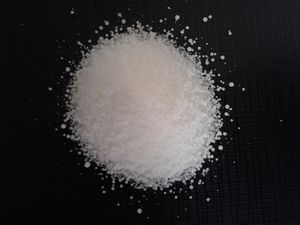Sodium bisulfate
Sodium bisulfate, also known as sodium hydrogen sulfate is the sodium salt of the bisulfate anion, with the molecular formula NaHSO4. It is an acid salt, formed by the partial neutralization of sulfuric acid with an equivalent of sodium, usually sodium chloride or sodium hydroxide.
Contents
Properties
Chemical
Sodium bisulfate will react with sodium chloride to release hydrogen chloride.
- NaHSO4 + NaCl → Na2SO4 + HCl
Sodium bisulfate is an acid salt. Heating (and even just sitting) can release sulfuric acid vapors, from small amounts to large quantities of fumes.
Physical
Sodium bisulfate is a white dry granular product. The anhydrous form is hygroscopic. Solutions of sodium bisulfate are acidic, 1M solution having a pH of < 1.
Availability
Sodium bisulfate is available as a pH lowering chemical for swimming pools.
Preparation
Sodium bisulfate is made by mixing stoichiometric quantities of sodium hydroxide or sodium chloride and sulfuric acid.
- NaOH + H2SO4 → NaHSO4 + H2O
- NaCl + H2SO4 → NaHSO4 + HCl
Projects
- Make hydrochloric acid
- Make nitric acid (it will give off mostly nitrogen dioxide fumes if you use an alkali nitrate)[1][2]
Handling
Safety
Sodium bisulfate will irritate the skin, eyes and mucous tissues on contact. Despite being a salt rather than a fully saturated acid, sodium bisulfate solutions have a much lower pH than many acids themselves, and should be treated with care. Prolonged exposure will damage the tissues.[3] Do not attempt to smell sodium bisulfate. It is common for a sample to release sulfuric acid vapors, and these can build up in a container.[4]
Storage
Sodium bisulfite should be stored in closed bottles.
Disposal
Sodium bisulfate is not very dangerous to the environment, though it should be neutralized first before disposal.
References
- ↑ http://www.sciencemadness.org/talk/viewthread.php?tid=18767
- ↑ https://www.youtube.com/watch?v=TtPiwbRA4N8
- ↑ http://www.sciencelab.com/msds.php?msdsId=9927267
- ↑ "The Volatile Chemist's" personal experience
